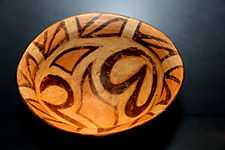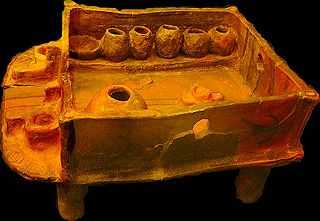Architecture of the Cucuteni–Trypillian culture
| Cucuteni-Trypillian culture (c. 4800 to 3000 BC) |
|---|
 Characteristic example of Cucuteni-Trypillian pottery |
| Topics |
| Related articles |
The chalcolithic Cucuteni-Trypillian culture left behind thousands of settlement ruins containing a wealth of archaeological artifacts attesting to their cultural and technological characteristics.[1]
Construction techniques
The houses of the Cucuteni-Trypillian settlements were constructed in several general ways:
- Wattle and daub homes.
- Log homes, called (Russian: площадки ploshchadki) in Russian.
- Semi-underground homes called Bordei.
Some Cucuteni-Trypillian homes were two-storeys tall, and evidence shows that the members of this culture sometimes decorated the outsides of their homes with many of the same complex red-ochre swirling designs that are to be found on their pottery. Most houses had thatched roofs and wooden floors covered with clay. Archaeologists have identified two types of house framing found at Cucuteni-Trypillian sites. One type, somewhat resembling the post and beam style, used evenly-distributed fork-shaped log pillars that were partially sunk vertically into the ground so that the fork was located at the top and supported the roof beams above. The other type of framing used vertical beams measuring 15–20 cm (6-8 inches) in diameter, or greater, which rested on horizontal ground-sill foundational timbers that were in turn fixed in place on top of the soil.
Most of the walls were built in the wattle-and-daub style. The construction of these houses first started by erecting the framework of larger timbers in place,(photo 1) which would take the weight of the structure, and then the space between these timbers would be filled in with a "wattle" made of pliable smaller branches and vines woven together to form a thin twiggy latticed net which was then affixed to the sturdy timbers.(photo 2) Onto this wattle framework the "daub" would be applied made of mostly dampened clay soil although sometimes mixed with small bits of straw and/or animal dung to help keep its structural integrity.(photo 3) The daub had to be applied with some force against the wattle in order for it to partially push through the twiggy framework, to which it would stick. Sometimes there would only be a single layer of wattle and at other times two wattle layers would be used; one for the interior and another for the exterior of the wall. Daub was applied on both sides of the wall, inside and out,(photo 4) creating a finished wall that was usually about 5 cm (2 inches) thick. Once applied it was smoothed before drying to create an air- and water-tight barrier against the elements.(photo 5) After the daub was fully dried it was usually painted with lime to prevent infestations of pests.(note: the photographic examples used in this paragraph were taken from the web page "Recreating a Cucuteni dwelling-house", hosted by The Archaeological Park Cucuteni, see "External Links" at bottom of this article)[2]
Sometimes the walls were made of horizontally laid timbers (similar to log homes) that were then covered with clay daub. Some examples have been found where the horizontal timbers were in turn covered with a wattle-and-daub layer. At other times the horizontal timbers would be covered with a layer of primitively-finished lumber. There was no standard practice in building walls during Neolithic times; sometimes, even in the same house, walls would be constructed with horizontal timbers while others would be covered with finished lumber or wattle-and-daub. This type of horizontal log construction found in Cucuteni-Trypillian houses is called (Russian: площадки ploshchadki) in Russian.[3][4]
Cucuteni-Trypillian houses were roofed with live turf or thatched reeds.[5] The shape of the house was usually rectangular but some were laid out in an "L" shape. Some of the houses were divided into separate rooms while others contained a semi-open functional space, or atrium.[6] Many of the Cucuteni-Trypillian houses were two-stories high.[7]
-
Detail of a fork pillar holding a roof beam, with wattle-and-daub layers revealed
-

Wall reconstruction showing a wall with two layers of wattle and daub laid over a timber frame post
-

Floor reconstruction showing a log floor covered in clay
-
Archaeological Cucuteni-Trypillian building structure imprints in clay
-
Vitrified clay bench
Bordei dwellings
Some of the houses found by archeologists were dugout earth houses, of the style called bordei in both Romanian (Romanian: ''bordei'') and Ukrainian (Ukrainian: бордей). Unlike surface dwellings characterized by walls with right angles and rectangular shapes the bordei houses were characterized by elliptical shapes. These houses would typically have a wooden floor that was about 1.5 meters (5 feet) below ground, which would place the roof at just above ground level.[6] Images of bordei homes may be seen at the Romanian Art Zone page[8]
-
A clay model of a figurine in a chair
-
A clay Precucuteni Goddess and chair
-
Clay models found at a Cucuteni-Trypillian site showing figurines sitting on a couch-like piece of furniture
House interior

Most of the Cucuteni-Trypillian houses were arranged by locating the front door opposite from the where the fireplace sat. Large ceramic pottery containers used to store water and grain were placed next to the fireplace. Other ceramic containers, including the more valuable painted pottery, would also be located near the fireplace. Some of the fine painted pottery for which this culture is known would be used for clothing storage but most of it seems to have been used in rituals.[9]
The number of fireplaces found within each house varied from just one (which was the most common) to several, or even none. Each of the fireplaces found in houses that had more than one would have its own specific use such as one for cooking, one for firing ceramics, etc. Most Cucuteni-Trypillian fireplaces were a type of open fire pit and were usually constructed on the floor by laying down a bed of clay mixed with broken pottery shards and then covering this with a smooth clay-plastered surface.
It is assumed that furniture was extensively used however, due to the climate of this region, wood does not preserve well here. However some of the many miniature clay figurines found at Cucuteni-Trypillian sites were placed sitting or reclining on different pieces of furniture, some of which resemble sofas, chairs, or even ovens. There is also some evidence of furniture being incorporated into the structure of the walls of houses by using woven branches covered with clay.[10]
References
- ↑ Mallory, James P (1989). In search of the Indo-Europeans: language, archaeology and myth. London: Thames and Hudson. ISBN 0-500-05052-X. OCLC 246601873.
- ↑ "Recreating a Cucuteni dwelling-house" (in English and Romanian). The Archaeological Park Cucuteni. Retrieved 28 November 2009.
- ↑ Darvill, Timothy (2003). "Archaeology Dictionary" (ONLINE SYSTEM OR SERVICE). definition: ploshchadki. The concise Oxford dictionary of archaeology. OCLC 425961211. Retrieved 30 November 2009.
- ↑ Kipfer, Barbara Ann. "Archaeology Wordsmith" (ONLINE SYSTEM OR SERVICE). definition: ploshchadki. Dr. Barbara Ann Kipfer. Retrieved 25 April 2014.
- ↑ Cucoș, Ștefan (1999). "Faza Cucuteni B în zona subcarpatică a Moldovei" [Cucuteni B period in the lower Carpathian region of Moldova]. Bibliotheca Memoriae antiquitatis (BMA) (Memorial Library antiquities) (in Romanian) (Piatra Neamț, Romania: Muzeul de Istorie Piatra Neamț (Historical Museum Piatra Neamț)) 6. OCLC 223302267.
- ↑ 6.0 6.1 Sorochin, Victor (2004). "Așezările cucuteniene tip Soloceni" [Soloceni type Cucuteni villages]. Memoria Antiqvitatis (Piatra Neamț, Romania: Muzeul de Istorie Piatra Neamț (Historical Museum Piatra Neamț)) 23: 167–202. OCLC 241363071.
- ↑ "Model of a Cucuteni-Trypillian two-storied house". The Trypillian Museum. Retrieved 29 November 2009.
- ↑ Grigorescu, Nicolae (1838–1907). "Bordei in padure" [Bordei in the forest]. Art Zone. Retrieved 6 December 2009An online reproduction of an oil painting done by Romanian artist Nicolae Grigorescu (1838—1907)
- ↑ Monah, Dan (2005), "Religion and art in Cucuteni culture", in Dumitroaia, Gheorghe, Muzeul Cucuteni prima pentru Romania [The first Cucuteni museum for Romania], Bibliotheca memoriae antiquitatis XV (in Romanian), Piatra-Neamț, Romania: Editura Foton, pp. 162–173, OCLC 319165024
- ↑ Кричевский (Krichevski), Евгений Юрьевич (Evgeniye Yurivich). "Трипольские площадки ; по раскопкам последних лет (Triploskiye ploshchadki : po raskopkam poslednič let)" [Trypillian ploshchadki : on the excavations of recent years]. Советская археология (Sovyetskaya arkheologiya Soviet Archeology) (in Russian) (Moscow: институтом археологии АН СССР (Archeological Institute A.N. USSR)) 6: 20–45. ISSN 0869-6063. OCLC 26671888this journal later changed its title to Российская археология (Russian archeology)
External links
| Wikimedia Commons has media related to Tripolye culture. |
| Wikimedia Commons has media related to Cucuteni culture. |
- Archaeological Park Cucuteni The website for the multi-institutional and international project entitled "Archaeological Park Cucuteni", which seeks to reconstruct the museum at Cucuteni, Romania, and to more effectively preserve this valuable heritage site (in English and Romanian).
- Cucuteni Culture The French Government's Ministry of Culture's page on Cucuteni Culture (in English).
- Cucuteni Culture The Romanian Dacian Museum page on Cucuteni Culture (in English).
- The Trypillia-USA-Project The Trypillian Civilization Society homepage (in English).
- Трипільська культура в Україні з колекції «Платар» Ukrainian language page about the Ukrainian Platar Collection of Trypillian Culture.
- Trypillian Culture from Ukraine A page from the UK-based group "Arattagar" about Trypillian Culture, which has many great photographs of the group's trip to the Trypillian Museum in Trypillia, Ukraine (in English).
- The Institute of Archaeomythology The homepage for The Institute of Archaeomythology, an international organization of scholars dedicated to fostering an interdisciplinary approach to cultural research with particular emphasis on the beliefs, rituals, social structure and symbolism of ancient societies. Much of their focus covers topics that relate to the Cucuteni-Trypillian Culture (in English).
- The Vădastra Village Project A living history museum in Romania, supported by many international institutions.
| ||||||||||||





